9 bathroom cleaning mistakes making your life harder, according to experts
Simplify your cleaning routine and make your bathroom shine by avoiding these all too common mistakes


We’d all rather be enjoying a long soak in the bath than a long scrub removing that limescale or grime, but what if you could make your bathroom chores more efficient and effective? Are you making the same bathroom cleaning mistakes each time – and ones that could easily be avoided?
Before you reach for the same cleaning products to do your quick blitz of the bathroom, try our expert tips. You’ll soon be in spa-bathroom heaven not scrubbing brush hell.
There are plenty of bathroom cleaning hacks you can try too, so what are you waiting for? Bring on the bathroom shine!
Bathroom cleaning mistakes
Make your bathroom ideas sparkle by avoiding these common bathroom cleaning pitfalls that could be making this chore harder and take longer.
1. Don’t clean the clutter
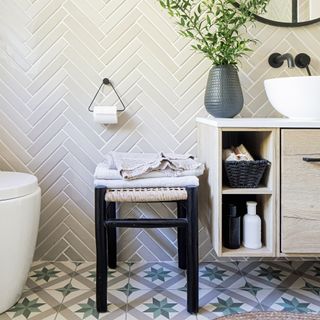
Start by decluttering your bathroom, removing any empties, finished loo rolls and dirty washing. ‘Wipe and put away anything that doesn’t belong there – ideally only have items out which are used on a daily basis,’ says Janine McDonald of Clear the Clutter Now.
‘Declutter under the sink and any cupboards, discarding items which have been opened for longer than the recommended time (check the open lid symbol on the packaging). Store items like-with-like, eg, all the shampoo and conditioner together, placing smaller bottles at the front to use first.’
2. Don’t wet clean on top of dust
A common error is wet cleaning on top of dirt and dust. ‘People don’t dust or vacuum their bathrooms before cleaning,’ says Lynsey Crombie, TV’s Queen of Clean (@lynsey_queenofclean), ‘which means they end up pushing around wet dust, which looks unsightly if left and then becomes harder to remove.’
Get the Ideal Home Newsletter
Sign up to our newsletter for style and decor inspiration, house makeovers, project advice and more.
Janine McDonald of Clear the Clutter Now says the order in which you dust is key: ‘Start at the top and work down - dust the cobwebs away from the corners of the room, light fittings and vents, sweep the floor (don't clean – this comes last).’
3. Don’t forget a supply of clean cloths
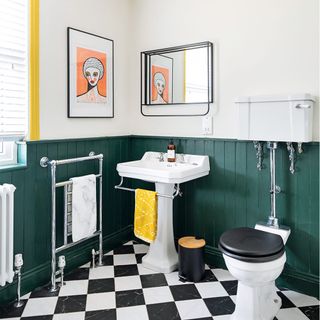
'One of the biggest mistakes is using just one cloth to clean the whole bathroom,’ says Vicky Saynor, owner of Bethnal & Bec Luxury Stays. 'If you do, you are just spreading the germs around. We use around 5/6 cloths to clean the shower, toilet, bath, shelves, mirrors and sink.’
‘Choose different coloured cloths,’ says Janine McDonald of Clear the Clutter Now, ‘for example blue for the loo, pink for the sink. The rhyming makes it easier to remember which is which.’
It’s worth keeping a small selection of cleaning products in your bathroom to do a daily wipe around: ‘Keeping on top of the cleaning is far easier than waiting and letting it build up,’ adds Janine, ‘although to make sure they are stored safely.’
Also swap any cleaning cloths daily, rather than letting one fester sink side.
4. Don’t mix chemicals
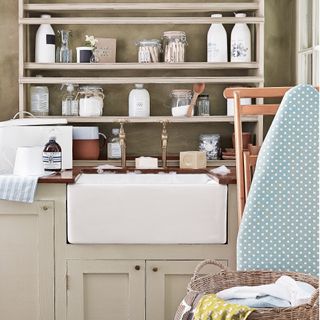
‘One of the most common – and potentially dangerous – mistakes when cleaning a bathroom is mixing chemicals,’ says Sam Hancock of @mummy_clean. ‘It’s also important to check the contact time on any disinfectants or antibacterial products. Don’t forget to rinse really well, so you don’t leave a residue.’
‘Use natural cleaning products such as bicarbonate of soda, white vinegar and pure essential oils to prevent the build-up of chemicals in your home,’ says Janine McDonald of Clear the Clutter Now.
‘We use just two cleaning products,’ says Vicky Saynor, owner of Bethnal & Bec Luxury Stays, ‘White Vinegar, and a probiotic natural cleanser that deals with dirt, limescale and bacteria but without the harsh chemicals on our hands/being breathed in.’
5. Don’t rush
‘Most people don’t leave the products long enough to work,’ says Lynsey Crombie, TV’s Queen of Clean. ‘If you read the back of most cleaners, you will see that product needs to sit on surfaces to work for a few minutes before rinsing.’
‘A deep bathroom clean will take around 30 minutes but this will vary dependent on size and the number of cabinets etc,’ adds Lynsey.
‘If you tend to leave cleaning your bathroom until limescale and mould have built up, then cleaning the bathroom could take around an hour,’ says Janine McDonald of Clear the Clutter Now.
6. Don’t forget daily chores
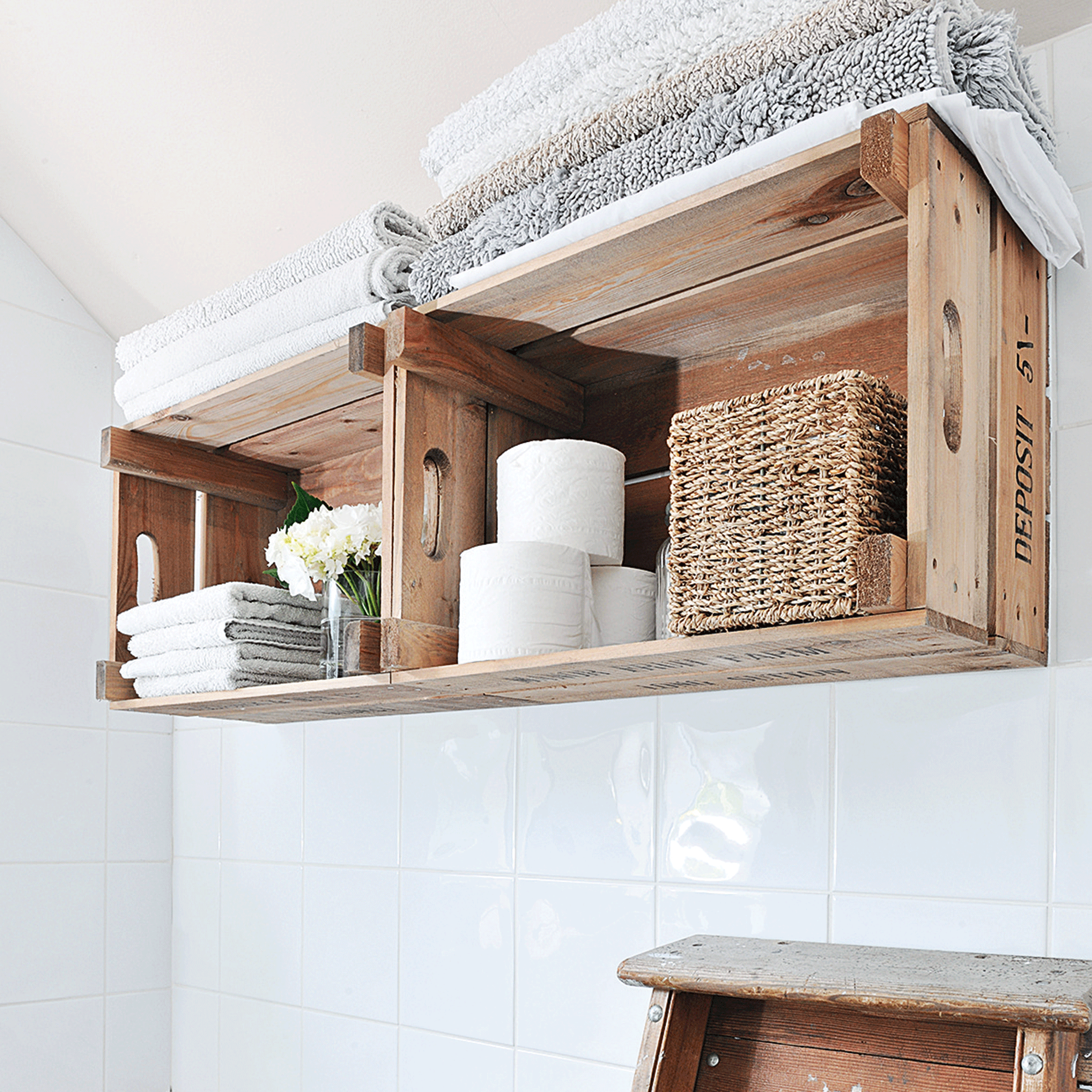
‘Water needs to be removed from shower screens instantly after showering to save water marks and limescale build up, simply keep a squeegee in the bathroom to remove water or a good quality thick microfibre cloth,’ says Lynsey Crombie, TV’s Queen of Clean. ‘And don’t forget to air your bathroom, either with an open window or an extractor fan.’
‘Pick up any laundry and dropped towels and pop them in the laundry basket (could use a point system for who puts all their washing in the basket - this works for adults too!),' says Janine McDonald of Clear the Clutter Now. ‘Empty the bathroom bin and wipe it out too,’ she adds.
7. Don’t ignore those out-of-sight places or hard-to-reach areas
‘Regularly cleaning the drains not only helps them flow better but improves the smell and reduces the risk of damaged pipes. Learning how to take your plugs apart properly, might seem a little hardcore, but it's a hygiene and cleanliness game changer,’ says Jessica Barclay, lifestyle and organisation coach, The Lifestyle Coach UK.
‘Likewise, don’t forget cleaning the showerhead; it’s a very satisfying job if it hasn’t been done for a while and is pretty easy. Just submerge the shower head in cleaning vinegar overnight. I usually do this in a very large sandwich bag and seal it around the shower head with a rubber band. You don’t even need to detach the head from the hose to do this.’
‘Don’t forget those hidden areas, such as on top of cupboards, the light fittings, door frames, door handles… the list could go on,’ says Sam Hancock.
8. Don’t trick your sense of smell

‘Often we associate a clean bathroom with the smell of artificial fragrance,’ says Jessica Barclay, lifestyle and organisation coach, The Lifestyle Coach UK.
'But the true test of cleanliness is how it smells without those fragrances. Opt for cleaning products without a scent; air out your bathroom while you clean, and choose for natural absorbers of smells, like bicarbonate of soda, while rubbing alcohol and white vinegar are great for cleaning.’
9. Don’t forget to schedule a deep clean
While your bathroom should take around 30 minutes once a week to stay lovely and clean, a deep clean – say every eight weeks is a must. ‘I always have some tunes on,’ says Jessica Barclay, lifestyle and organisation coach, The Lifestyle Coach UK.
‘The amount of time it should take to clean a bathroom depends on the size, the fittings, the age of the bath/shower, if there is a toilet and basin, etc,’ says Sam Hancock. ‘For me to fully deep clean ours, it can take three hours, for a quick clean it can take 15 minutes. I’d always deep clean when necessary and then top up clean in between.’
FAQs
What are the basic rules to follow when cleaning a bathroom?
‘Bathrooms often gather loose hair, fluff, nails, etc, so start with a quick sweep round of the hoover to lift off the loose bits,’ says Jessica Barclay, lifestyle and organisation coach, The Lifestyle Coach UK.
‘Use the hand towel and bathmat to dry out the shower tray, bath, and shower screens – it’s a lot easier to clean a dry surface because you aren’t diluting your cleaning products or saturating your cloth in the process.
'Next, use the toilet brush to plunge the toilet to lower the water level before spraying it with homemade toilet cleaner and wedging the toilet seat open with the loo brush. Then start from the highest point and work your way down, leaving the sink until last, so you can use it for washing out the plugs and other small bits.
'Also, make sure the toilet brush pot is emptied down the toilet before the final flush. Finally, polish any metal wear and add fresh towels.’

What is the filthiest spot in a bathroom?
‘You'd think the dirtiest place in the bathroom would be the toilet, however, whilst this is high on the list, it's not the top one. Radiators and towel rails have been found to be the most contaminated as these tend to be cleaned far less than the loo,’ says Janine McDonald of Clear the Clutter Now.
‘Don’t forget plugholes and plugs,’ says Vicky Saynor, owner of Bethnal & Bec Luxury Stays. ‘They can get covered in soap scum and hair, especially underneath.’
‘Yes, plugs,’ agrees says Jessica Barclay, lifestyle and organisation coach, The Lifestyle Coach UK, ‘too often, they can get left for years and many people don’t know how quick and easy it is to lift them out.’
How do professionals clean a bathroom?
‘We start by clearing as many surfaces as we can to create a clear canvas,’ says Lynsey Crombie, TV’s Queen of Clean and former cleaner.
'Pros will always vacuum first using the nozzle to get into all those awkward areas, with a steam cleaner to blast away dust and debris in awkward corners. We use good bathroom-specific products or white vinegar, which is great for limescale remover and open the window while cleaning to keep the space well-ventilated.
'We know to spray and allow products to work, starting cleaning from the highest point (as dust falls), using a flat-headed mop to reach up high to tiles and the top of the shower screen. We always put back clean towels and bath towels, restock toilet roll and any products!’
Are you guilty of any of these mistakes?
Jennifer Morgan is an award-winning editor, writer and stylist, with over 25 years’ experience writing, styling and editing home interest magazines. Jennifer was the deputy editor of Ideal Home from 2008-2010, before launching Ideal Home’s sister title, Style at Home in 2010. Jennifer went on to launch several craft magazines and websites, before going freelance in 2016, with a client list that includes John Lewis, Dunlem and Nordic House. Today, she writes for Ideal Home, Real Homes, Waitrose, Woman & Home, Sainsbury’s Magazine and Homes & Gardens. But it was during lockdown that Jennifer realised her dream of publishing her own magazine – Simply Scandi.
- Holly CockburnContent Editor
-
 When to repot sunflower seedlings to ensure a sunny display this blooming season
When to repot sunflower seedlings to ensure a sunny display this blooming seasonSize really does matter
By Lauren Bradbury
-
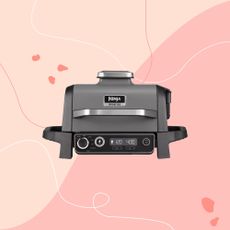 The world's first outdoor air fryer is now cheaper than ever - and will make your next BBQ easier than ever
The world's first outdoor air fryer is now cheaper than ever - and will make your next BBQ easier than everA garden air fryer, you say? Ninja's got it covered
By Molly Cleary
-
 How to grow melons – a step-by-step guide to cultivating the perfect summer snack, according to experts
How to grow melons – a step-by-step guide to cultivating the perfect summer snack, according to expertsEnsure a bumper crop, even in the UK
By Jullia Joson